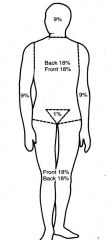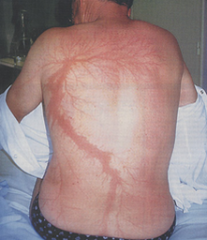![]()
![]()
![]()
Use LEFT and RIGHT arrow keys to navigate between flashcards;
Use UP and DOWN arrow keys to flip the card;
H to show hint;
A reads text to speech;
63 Cards in this Set
- Front
- Back
|
Statistics on fire injury in US
|
-4000 house fires/year, 80% are accidents
-Third most common source of fatal unintentional injury in US in ages 1-10 -House fires is most common circumstance |
|
|
Individuals most at risk for fire injuries
|
Children and elderly
|
|
|
Circumstances of thermal injury
|
-House fires (cigarettes, candles, kitchen equipment, ignition of clothing)
-Vehicle fires with or without collision -Explosion-related fires -Flammable liquids -Scalds -Other: microwave, chemical, radiation |
|
|
How do fires kill?
|
-Inhalation of gases, including carbon monoxide and oxygen-depleted air
-Some nitrogen-containing materials (synthetics) liberate cyanide when burned -Burns |
|
|
First degree burns
|
-Superficial and epidermis only (sunburn)
-Redness -Edema -No blistering |
|
|
Second degree burns
|
-Deeper penetration involving epidermis and dermis with blistering
-Most painful |
|
|
Third degree burns
|
-Full thickness of skin
-Collapsed blisters -Skin sloughs off -Red-brown color -Will require grafting -Nerve destruction may make less painful |
|
|
Fourth degree burns
|
-Charring with tissue loss
-Looks like charcoal -Usually will not be saved |
|
|
Carbon monoxide
|
-Chemical asphyxiant
-Gas resulting from incomplete combustion of carbon-containing materials -Binds to blood hemoglobin over 200% more avidly than oxygen, so that oxygen carrying capacity of red blood cells is disrupted -Older vehicles, faulty heating systems, and cigarettes all produce significant amount of CO |
|
|
Case study: Singed nares, no soot in airways
|
Flash fire caused by smoking with an oxygen tank on
|
|
|
Case study: Soot in airway, tracheal bifurcation
|
Smoke inhalation
|
|
|
Skin splitting
|
-Artifact of a fire, not antemortem injury
-Usually occurs parallel to muscle fibers |
|
|
Level of CO causing death
|
Varies with age and health
|
|
|
Level of CO for visible cherry red coloration of skin
|
Generally about 30%
|
|
|
Situation where there is little or no CO, but suffocation occurs due to consumption of oxygen in air
|
Very hot or flash fire
|
|

|
-Used to determine what percentage of body is burned
-Second degree or above |
|
|
Baux score
|
Age + Percent surface area with second degree or worse burns = percent mortality
Example: 50 year old with 20% BSA burns has 70% likelihood of dying -Less accurate today with burn center treatment -Does not take into account inhalation |
|
|
Range of changes seen in acute fire deaths
|
-Soot deposits
-Skin slippage -Heat fixation: pugilistic posture -Tissue splitting -Charring -Heat fractures mimic blunt trauma -Inhalation changes: soot in nares and lower airways, cherry-red liver and internal organs |
|
|
What is standard in an autopsy of decedents with severe burns? Why?
|
-Full body radiographs
-Identification purposes (teeth, bone structures) -To locate foreign objects (i.e., bullets) |
|
|
Case study: 78 year old female found on metal frame of chair in room of house mostly charred by fire. Cigarette butts around and under decedent. Autopsy showed no soot in airways.
|
Death of natural causes and cigarettes cause fire after death
|
|
|
Case study: 31 year old driver of a vehicle that struck two cars before overturning. Vehicle caught fire before driver could be rescues. No soot in airways. Autopsy showed surface charring and partial pugilistic posture, extensive skeletal fractures with hemorrhage, spinal cord transection. Tox shows 0.36 PCP and less than 10% of CO
|
Died before the car caught on fire (because of no soot in airways)
|
|
|
Time to injury with scald burns
|
-Inversely related to water temperature
-10 minutes to full thickness at 120 degrees F -30 seconds at 130 degrees F -7 seconds at 140 degree F |
|
|
Scald burns indicating child abuse
|
-When a child is placed in hot water, they will reflexively retract their legs, so you will see a certain burn pattern
-Sparing of back of knees |
|
|
Manner of death in fire deaths
|
-Dependent on outcome of police/fire investigation
-How did fire/thermal injury occur? -Accident -Suicide -Homicide (arson) |
|
|
DNA recovered from fire scenes
|
-DNA survives high heat
-What looks like a useless burnt item may contain recoverable DNA evidence |
|
|
Thermal body changes in fire deaths may occur...
|
-Before or after death
-May mimic injury such as blunt trauma and also may obscure injuries |
|
|
An important contributor to mortality
|
Inhalation injury
|
|
|
An important question the autopsy of a fire death may answer
|
Was the decedent alive during the fire?
|
|
|
_______ is often critical to determining manner of death and should be pursued vigorously from outset
|
Body identification
|
|
|
Definition of explosion
|
-Chemical conversion of solid or liquid to a gas and resulting rapid release of energy
-Characterized by "positive pressure wave" that causes blast injury |
|
|
Explosion events with a high likelihood of multiple fatalities
|
-Bombs
-Vehicles -Vehicles driving into gas lines -Suicides -Trapped gas in homes, mines, etc. |
|
|
Primary blast injury
|
-Occurs when energy from an explosion (positive pressure wave) acts on body
-Greatest injuries are to gas-filled structures |
|
|
Categories of blast injuries
|
-Primary
-Secondary -Tertiary -Quarternary |
|
|
Categories of propagation of blast
|
-Air blast
-Water blast -Solid object in contact with body (steel deck, concrete floor) |
|
|
Injuries caused by air blasts
|
-Characteristic "blast lung"
-Eardrum -Retinal hemorrhages; secondary air emboli due to lung injury |
|
|
Injuries caused by water blasts
|
-Lacerations of gastrointestinal tract
-Lacerations of urinary bladder |
|
|
Injuries caused by steel/concrete floor from subadjacent/adjacent explosions
|
Simulate injuries from feet-first falls
|
|
|
Secondary blast injury
|
-Impact by flying objects propelled by blast
-Radiographs helpful in documenting foreign objects in body |
|
|
Tertiary blast injury
|
-Acceleration/deceleration as body is thrown
-Similar to blunt injury of falls from height |
|
|
Quarternary/miscellaneous blast injury
|
For example, building collapse
|
|
|
Role of medical examiner in mass fatality events
|
-Examine decedents
-Identify, document and collect evidence in/on bodies -Determine and issue opinions on cause and manner of death -Identify decedents -Release bodies |
|
|
During a mass fatality event, the __________ continues at the medical examiner's office.
|
Usual case load (role of D-MORT)
|
|
|
D-MORT
|
-Disaster Mortuary Operational Response Team
-Specialized personnel activated as temporary federal employees to assist local medical examiner/coroner; multidisciplinary as needed -Provide victim identification and mortuary services: temporary morgue services, victim identification, forensic dental, pathology and anthropology, processing, preparation and release of remains |
|
|
Types of contaminated/hazardous remains
|
-Radiation
-Microbial pathogens -Toxins -Chemicals |
|
|
Considerations while working with contaminated/hazardous remains
|
-Use universal precautions
-Wear protective gear, decontamination procedures required vary -Potential dangers to public, OCME and other agency personnel, funeral homes/families on release -Limitation of autopsy: weighing need for evidence/documentation against risks to investigators, limited resources -Perform “Index case”: full autopsy followed by limited exams with radiology of others -Both real and perceived dangers of concern |
|
|
Electrocutions
|
-Traditionally divided into low (less than 1000V) and high voltage
-Low voltage kills by ventricular fibrillation -Sometimes, if there is prolonged contact with low voltage, death occurs due to muscle paralysis or asphyxia -High voltage kills by cardiac arrest or electrothermal injuries |
|
|
Voltage range of lightning
|
10-100 million V
|
|
|
Voltage range of house wall outlets
|
110 to 120 V
|
|
|
Voltage range of third rail in Metro
|
600 V DC
|
|
|
Voltage range of electric chair
|
2000 to 2200 AC @ current of 7-12 amperes
|
|
|
Ohm's law
|
-States that the current through a conductor between two points is directly proportional to the potential difference across the two points
-As resistance falls at a given voltage, current flow increases |
|
|
Injuries from low voltage electrocutions
|
-Low resistance will show non-specific findings to subtle burns
-High resistance will show classic burns |
|
|
Injuries from high voltage electrocutions
|
-Scorching of clothing/hair
-Dramatic burns -Metal effects -Arcing occurs and greater than 350 V -Lichtenburg figure |
|
|
Lichtenberg figure
|

-Transient characteristic mark in lightning injury
-Fern-like pattern -Red mark on skin of unknown cause -Usually appears after one hour and disappears after 24 hours |
|
|
Accidental electrocutions
|
-Work/industrial settings
-Autopsy finding subtle in low voltage deaths involving low resistance skin -High risk to fetus |
|
|
Scene investigation and reconstruction steps taken at an accidental electrocution
|
-Evaluate danger and notify utility
-Examine clothing -Examine/collect appliances involved |
|
|
____, _____ skin has higher resistance and exhibits more injury.
|
Dry, thick
|
|
|
Current of electrical weapons (taser, stun gun)
|
Approximately 50,000 V, 2 to 10 milliamps
|
|
|
TASER
|
-Compressed nitrogen firing of two metal probes with insulated wires 15 or 21 feets long
-Can go through clothing but each probe must make contact -Autopsy will show paired punctures |
|
|
Stun gun
|
-Electrodes must be held against subject
-Autopsy will show paired red marks |
|
|
Are lightning strikes survivable?
|
Yes (less than 50% are fatal)
|
|
|
An inhaled substance responsible for many house fire deaths is _____. What physical finding may it cause?
|
Carbon monoxide. Cherry red color in CO levels of about 30%.
|
|
|
Cyanide
|
Dangerous inhaled substance liberated in some fires
|

